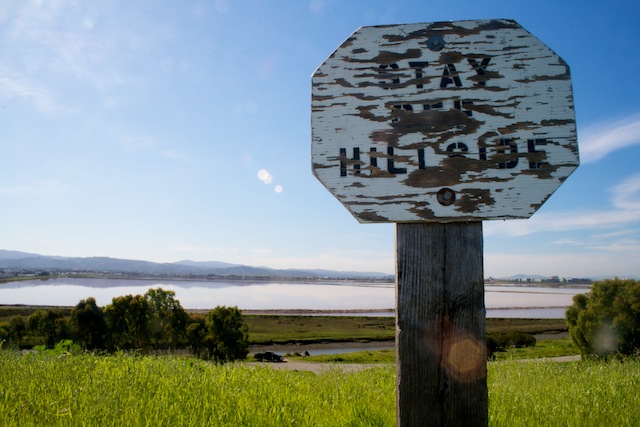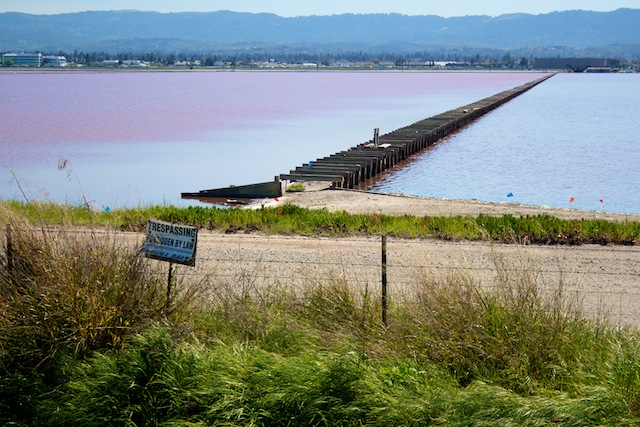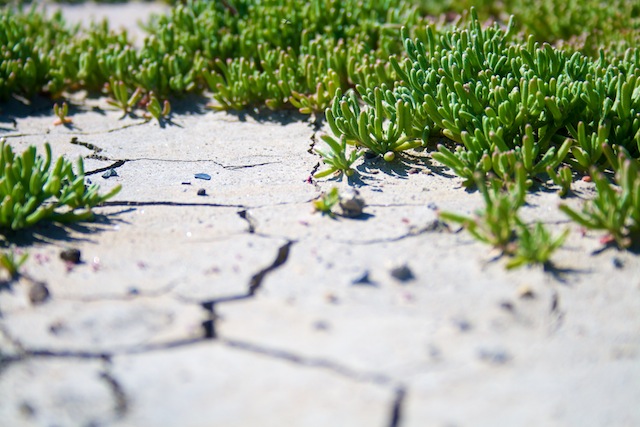
These salt ponds are going to be transformed in the next few years. The question is how. (Photo by Matt Baume.)
In a collection of salt evaporation ponds tucked between a freeway, a sleepy little marina, and the headquarters of Dreamworks Animation, the San Francisco Bay’s ecological future hangs in the balance.
The ponds themselves look deceptively blank: Vast flat rectangles of shallow water once used by Cargill to produce salt, the two-and-a-quarter square miles are fenced-off and nearly featureless, like an enormous bank of flattened solar panels.
To the west is Bair Island, itself a former salt pond. After four years of restoration, veiny tributaries and puffs of native scrub have begun to reemerge, drawing threatened species like the California Clapper Rail and Salt Marsh Harvest Mouse.
To the east is Bayfront Park, a capped landfill where you can climb a slope with rolling green hills on one side and Cargill’s barren salt ponds on the other.
Although the future is uncertain, this much is clear: The salt ponds are going away. But there’s a debate over what takes their place, and both parties say they have lofty, environmentally friendly goals.
On one side, David Lewis, executive director of the environmental group Save the Bay: “I grew up here, in Palo Alto,” he says. “When I was a kid growing up, and there was still major salt production going on, the salt pile was a major landmark. It’s basically right next to the 101, and it was at least five or six stories high, and it looked like snow.”
On the other, urban planner Peter Calthorpe, whose plan to develop the salt ponds is fiercely opposed by Save the Bay: “I have a very personal connection because I grew up in Palo Alto,” says Calthorpe, one of the founders of the Congress for the New Urbanism. “Growing up there, nobody ever went to the bay side,” Calthorpe continues. “When we wanted open space, we went to the hills. … In the peninsula, there’s very few places you can go and be in relationship to the bay.”
There’s no debate that the San Francisco Bay desperately needs wetlands restoration. The 1999 report “Baylands Ecosystem Habitat Goals” estimated that of the original 190,000 acres of tidal marsh, only 16,000 remained. Of 500 species of fish and wildlife, 20 were endangered or threatened. The report recommended that 100,000 acres of tidal wetlands be restored.
Twelve years later, 44,000 acres now exist, with 32,000 anticipated over the next few years. That’s largely thanks to the advocacy of Save the Bay, which was founded in 1961 to prevent a plan that would have filled the entire waterfront with urban development, reducing miles of bay to a thin river.
Since then, Save the Bay’s initiatives have run the gamut, from blocking runway expansion at San Francisco International Airport to identifying violations of the Clean Water Act to pushing for plastic-bag bans.
Now, they’ve set their sights on stopping Arizona real estate company DMB from implementing its Saltworks Plan.
Several years in the works, the Saltworks Plan is DMB’s attempt to turn the 1,400-acre Cargill salt ponds into a cluster of high-density housing projects, mixed with parks, sports fields, and some wetland restoration. Peter Calthorpe is chief designer.
The Saltworks Plan aims for a balance on the 1,400-acre site: 804 acres of open space, and 632 acres of development. Some 436 acres would be set aside for wetland restoration, an interpretive center, and schools. Parks and rec would comprise another 255 acres, and 113 acres would go toward buffers and sports facilities. The development would include extensive bike paths and an extension of the San Francisco Bay Trail.
 Urbanist Peter Calthorpe believes a development that includes dense housing, parks, and wetlands provides multiple benefits. Environmental group Save the Bay wants them restored to tidal marsh.Photo: Matt Baume
Urbanist Peter Calthorpe believes a development that includes dense housing, parks, and wetlands provides multiple benefits. Environmental group Save the Bay wants them restored to tidal marsh.Photo: Matt Baume
High-density housing would occupy the remainder of the land.
So why build at all? Why not turn the entire site into wetlands?
For Calthorpe, it comes down to the San Francisco Bay Area’s desperate need to balance jobs and homes. It’s not just an environmental issue, he says; it’s also about social justice.
According to the regional Metropolitan Transportation Commission, Redwood City — within whose bounds the salt ponds lie — is classified as a major regional employment center, hosting between 50,000 to 100,000 jobs at employers like Google, Yahoo, Oracle, and Kaiser Permanente.
There’s just one problem: not enough residents to fill the jobs.
“For four decades, we’ve been building more jobs than housing,” Calthorpe says. “In Silicon Valley and the Peninsula, that problem has doubled. Because of that, we’re spreading outward. There’s 200,000 in-commuters every day into the Bay Area — people who can’t afford to live near their jobs.”
The housing shortage doesn’t just put tens of thousands of air-choking cars on the road, Calthorpe says. It also causes home prices to spike, with San Francisco and San Jose homes selling for around three times the national median price.
Options for improving density with urban infill are limited, argue proponents of the Saltworks development. There are no other sites suitable for restoring the jobs/housing balance.
It’s hard to predict what proposed new homes in the development would cost, since the size, timing, and complexity of the project are still moving targets. There’s likely to be a wide range of prices, Calthorpe says, with at least 15 percent of units classified as affordable housing. The density will help keep prices down, he adds.
To its backers, the appeal of the Saltworks Plan is clear. It strikes a balance between sustainable development, wetland restoration, and regional jobs and housing — and it’s Redwood City’s only chance to make that play.
David Lewis doesn’t see it that way, and at first, neither did One Bay Area, a planning initiative from the Metropolitan Transportation Commission and the Association of Bay Area Governments (ABAG). Tasked with planning the region’s sustainable growth, One Bay Area released an Initial Vision Scenario last month, calling for 97 percent of new housing to be built within the existing urban footprint.
Rather than building on undeveloped land, the document cites infill potential along highways: Telegraph Ave., International Blvd., Mission Blvd., El Camino Real, San Pablo Ave. All told, One Bay Area expected the number of regional households to grow by 902,600 by 2035.
But of those households, the report anticipated that San Mateo County, where Redwood City is, will account for just 93,800 units. The bulk of new housing will rise far across the bay, in Contra Costa County (154,000 new homes), Alameda County (212,700 new homes), and Santa Clara County (253,900 new homes).
According to Calthorpe, the claim that 97 percent of necessary housing could be built within existing urban areas is based on out-of-date housing projections. Calthorpe claims that planners have chronically underestimated the need for housing, and points out that One Bay Area increased the projected need for housing by 250,000.
Save the Bay has rounded up a lengthy roster of local opponents to the Saltworks project. They point out that formal comments to the city are 10-to-1 opposed to the project, with residents writing, “I fear a disaster in the making,” and “This isn’t just about housing, this is also about good planning.”
The Sequoia Union High School district estimated that the new residences could strain existing facilities — although the plan for the development calls for new schools to be built. And even the League of Women Voters has weighed in, claiming that the project “does not concentrate development along existing transportation corridors.”
 Save the Bay wants to restore the wetlands to their natural state.Photo: Matt Baume
Save the Bay wants to restore the wetlands to their natural state.Photo: Matt Baume
As crucial as new housing is, there’s also no arguing that restored wetlands are sorely needed. Wetlands protect cities by slowing wave energy and absorbing floodwater. They reduce the need for levees, and sequester carbon. Plants filter water by absorbing and retaining pollutants.
Restoration would benefit animal life as well. According to the 1999 report on baylands habitat, restored salt ponds should provide islets and foraging for plovers and terns.
Calthorpe’s plan for the Saltworks includes such restorations — in fact, it would act as both levee and habitat. “You can build an engineering levee that’s riprap [piles of rock] and concrete,” he says, “or we can turn those levees into grand parkways, and we slope the edges and turn them into complex wetland ecologies. It’s a more expensive configuration. And it’s a configuration that the Saltworks is planning to put on the ground.”
The fact that some of that ecology would be squeezed out by development doesn’t much matter, Calthorpe says. “There’s plenty of bay salt ponds to be converted. Plus or minus 700 acres is 2 percent of what needs to be restored. Does that have a huge environmental impact? No.”
For now, the site isn’t serving anyone, a nearly empty void between highways and habitats. The primary occupants are brine shrimp that turn the ponds various shades of red. When seen from airplane windows, the colorful geometric shapes look like a vast work of modern art.
But David Lewis sees more than that when he stands at the edge of the water. “I see a site that’s crying out to be restored to tidal marsh,” he said. “If Save the Bay hadn’t started the successful movement to stop more of the bay from being filled in, and won a moratorium on additional landfill in the bay, all of the shallow areas could have been filled in and we’d have had a narrow river. That success is celebrated by the Bay Area. It’s proud of the bay’s history — stopping inappropriate development in the bay.”
“The frustrating thing to me,” Peter Calthorpe says, “is that I do a lot of work and I rarely get to see a site that offers so many opportunities for good things. And to reduce it to one thing is silly when you can do six good things.”
Editor’s note: We’ve added the video below, from the Redwood City Saltworks developers, at the request of Peter Calthorpe. It includes footage of parts of the site that were not accessible to our reporter.
[vodpod id=ExternalVideo.1011868&w=425&h=350&fv=%26bgColor%3D0xFFFFFF%26configFile%3D%26serverName%3Dinteractivate.flash.internapcdn.net%26appName%3Dinteractivate_vitalstream_com%2F_definst_%26streamName%3Drcsw%2FRCS_site_ed_v8_1%26autoPlay%3Dfalse%26skinName%3Dhttp%3A%2F%2Fhttp.vitalstreamcdn.com%2Fflashskins%2FhaloSkin_1%26bufferTime%3D3%26autoRewind%3Dfalse%26serverName%3Dinteractivate.flash.internapcdn.net]



